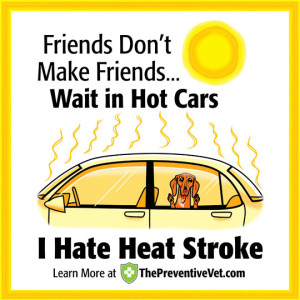With warmer days comes summer fun like going to the lake, hiking, backyard BBQ’s but with these activities comes potential danger! We always think this will never happen to our pet…. You have a water bowl out for your dog in the back yard, you take short walks or you may think your cat is ok in your cat because you’ll be quick in the store. Look over these tips & information so that this situation will never happen to you!
Heatstroke occurs when normal body mechanisms cannot keep the body’s temperature in a safe range. Animals do not have efficient cooling systems (like humans who sweat) and get overheated easily. A dog with moderate heatstroke (body temperature from 104º to 106ºF) can recover within an hour if given prompt first aid and veterinary care (normal body temperature is 100-102.5°F). Severe heatstroke (body temperature over 106ºF) can be deadly and immediate veterinary assistance is needed.
A dog or cat suffering from heatstroke will display several signs:
-Rapid panting
-Bright red tongue
-Red or pale gums
-Thick, sticky saliva
-Depression
-Weakness
-Dizziness
-Vomiting – sometimes with blood
-Diarrhea
-Shock
-Coma
What you should do:
Remove the pet from the hot area immediately. Prior to taking him to your veterinarian,you can try to lower his temperature by wetting him thoroughly with cool water (for very small dogs, use lukewarm water), then increase air movement around him with a fan. CAUTION: Using very cold water can actually be counterproductive. Cooling too quickly and especially allowing his body temperature to become too low can cause other life-threatening medical conditions. The rectal temperature should be checked every 5 minutes. Once the body temperature is 103ºF, the cooling measures should be stopped and the dog should be dried thoroughly and covered so he does not continue to lose heat. Even if the dog appears to be recovering, take him to your veterinarian as soon as possible. He should still be examined since he may be dehydrated or have other complications.
Allow free access to water or a children’s rehydrating solution if the dog can drink on his own. Do not try to force-feed cold water; the dog may inhale it or choke.
What your veterinarian will do:
Your veterinarian will lower your dog’s body temperature to a safe range (if you have not already) and continually monitor his temperature. Your dog will be given fluids, and possibly oxygen. He will be monitored for shock, respiratory distress, kidney failure, heart abnormalities, and other complications, and treated accordingly. Blood samples may be taken before and during the treatment. The clotting time of the blood will be monitored, since clotting problems are a common complication.
Aftercare
Dogs with moderate heatstroke often recover without complicating health problems. Severe heatstroke can cause organ damage that might need ongoing care such as a special diet prescribed by your veterinarian. Dogs who suffer from heatstroke once increase their risk for getting it again and steps must be taken to prevent it on hot, humid days.
Prevention
During the summer months in Dallas, TX, we experience high and potentially dangerous temperatures for not only ourselves, but for our pets as well. Due to the harmful effects of heat exposure, it’s crucial to understand the best ways to prevent heat stroke for your furry friends. The main one is ensuring your cats and dogs have access to plenty of fresh water and shade throughout the day. Water will keep their bodies hydrated as the heat can drain them of nutrients.
Hopefully this shouldn’t be a surprise, but NEVER leave your pets in a parked car (even if the windows are rolled down or you’ll “just be back in a couple minutes”). Temperatures (reaching upwards of 140 degrees) within a metal car can soar to life-threatening levels within minutes even parked in a shaded area – DON’T DO IT.
Daily Exercise and walks should be limited to early morning or evening hours when it is going to be the coolest period in Dallas. It’s never a bad idea to use pet-safe sunscreen for places like the tips of ears, the nose, and other exposed areas to prevent sunburn. Additionally, be mindful of hot asphalt pavements which can burn your pet’s paws. We recommend testing the surface first before letting your pet walk on it.
If your pet shows signs of heatstroke, such as excessive panting, drooling, or lethargy, move them to a cooler area immediately and consult your veterinarian at Cornerstone Animal Clinic.
By taking these precautions, you can help ensure your furry friends enjoy a safe and comfortable summer.
Any pet that cannot cool themselves off is at risk for heatstroke. As a summary and good rule of thumb, please follow these guidelines to help prevent serious problems.
-Keep pets with predisposing conditions like heart disease, obesity, older age, or breathing problems cool and in the shade. Even normal activity for these pets can be harmful.
-Provide access to water at all times.
-Do not leave your pet in a hot parked car even if you’re in the shade or will only be gone a short time. The temperature inside a parked car can quickly reach up to 140 degrees.



